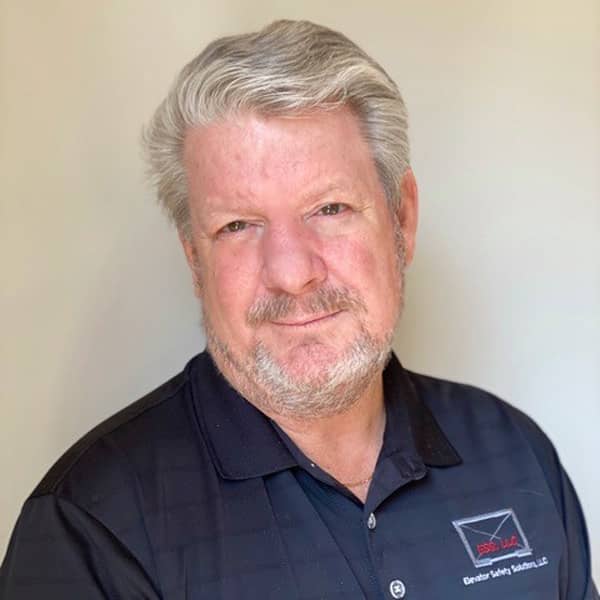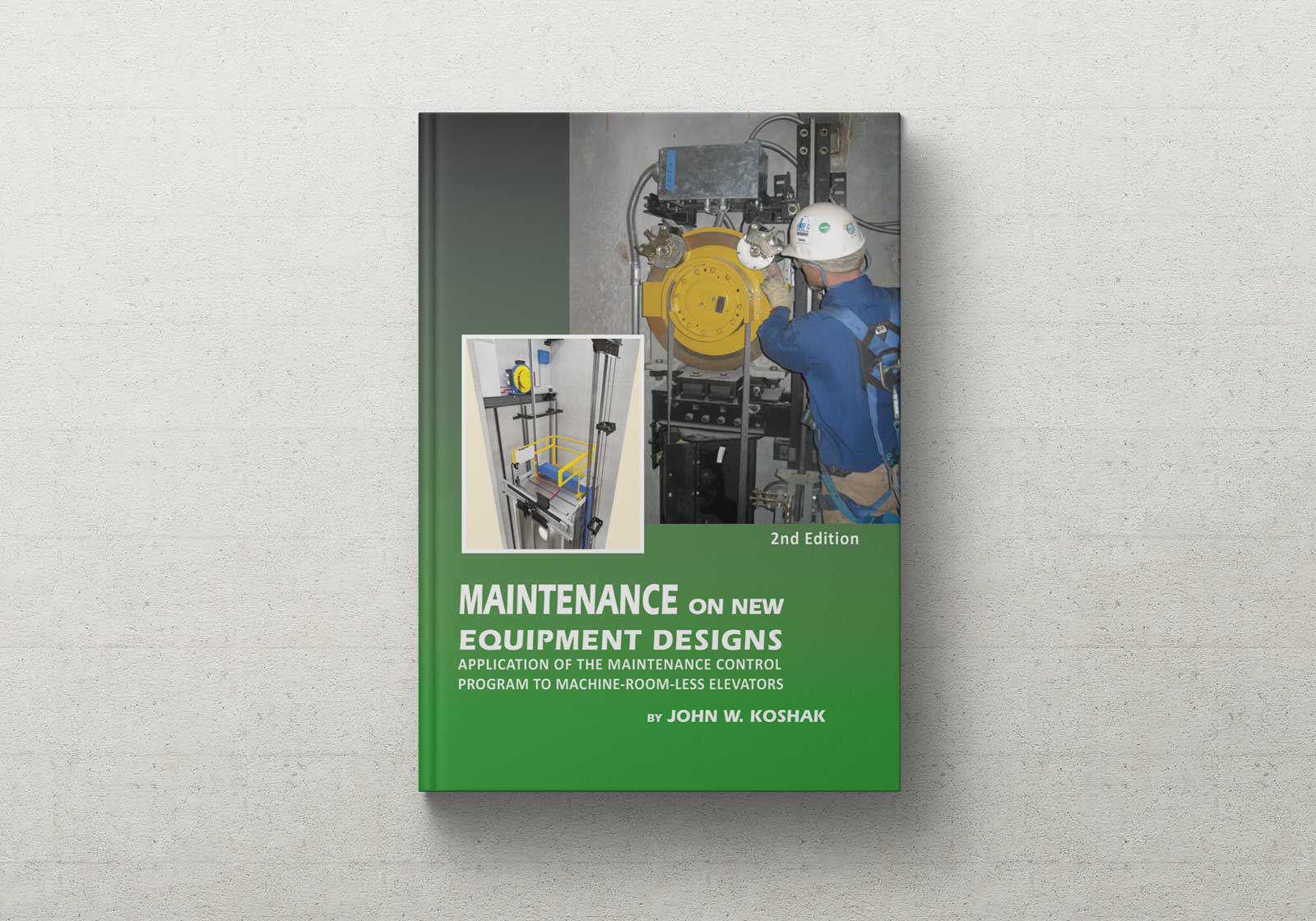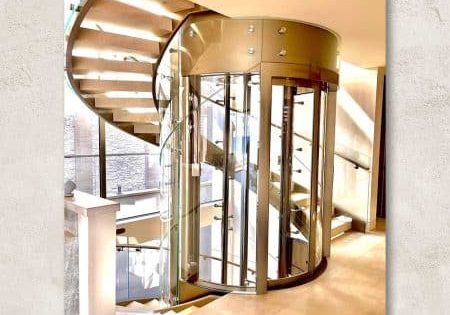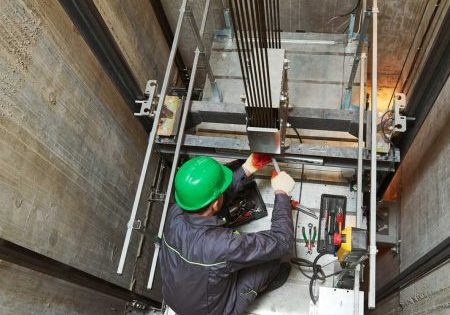Application of the Existing Maintenance Control Program to Machine-Room-Less Elevators
Book’s second edition reflects ongoing changes in the elevator industry.
Author John W. Koshak observes a “sea change” has occurred in the elevator industry since the first edition of Maintenance on New Equipment Designs, Application of the Maintenance Control Program to Machine-Room-Less Elevators was published in 2010. When the first edition of Maintenance debuted, machine-room-less (MRL) systems had been around for 14 years. That has now transitioned into 27 years — and there is a need for an updated, second edition. Available from Elevator Books, the second edition reflects ongoing changes in code brought about by a proliferation of MRL elevators. The 102-page volume is divided into 10 chapters, each followed by study questions and two appendixes: a list of applicable components referenced in Section 8.6 of ASME A17.1a-2008/CSA B44a-08 and answers to the study questions.
From the get-go, Koshak provides a list of acronyms used in the book, as well as a thorough note of gratitude to the numerous code experts — some of whom have since passed away — for their valuable input. Chapters are Maintenance, Maintenance Control Program (MCP), Performing Maintenance, Governor and Safety Systems, Electric Driving Machines, Suspension Means, Brakes, Ascending Car Overspeed Protection and Unintended Car Movement Protection, Controllers, and Listing and Labeling.
The book includes a wealth of detailed illustrations — both drawings and color photographs — depicting both legacy and modern equipment and work areas such as machine rooms, cartops, limit switches and governors. The book describes and aims to impart thorough knowledge about:
- Maintenance (code applicable to safety, performance and working spaces; and components)
- MCP (history, code requirements, frequency, applicable components, code data plates, jumper control programs and critical operating circuits)
- Performing maintenance (legacy equipment and MRLs, specifically, car tops and pits; machine rooms; mainline power; driving machines; escalators and moving walks; and checklists)
- Governor and safety systems (code history, pull-through force, rope-restraining devices, job hazard analysis, MRLs, training providers and critical maintenance tasks)
- Electric driving machines (MRL risks, inspector guidebooks, lighting, code requirements and the differences between legacy and MRL driving machines)
- Suspension means (latest standards; requirements and criteria for steel wire, non-steel wire and elastomeric-coated steel belt ropes; frequency of repair or alteration; monitoring systems; and the procedures for tests, periodic inspections, maintenance, replacement, adjustments and repairs for new systems)
- Brakes (safety cornerstones, allowances for new suspension systems, code and maintenance requirements and MRL-specific features and processes)
- Ascending-car overspeed protection and unintended car movement protection (code requirements, maximum distance of permittable movement, monitoring via software or electronics, product-specific procedures and MCP requirements)
- Controllers (MRL key features, subsystems, types, capabilities, positioning, test/inspection panels and product-specific procedures)
- Listing and labeling (requirements for components; E/E/PES devices, including code requirements, technologies, replacement, MCP and listing requirements; and PLCs)
Koshak says:
“Writing is easy — a keyboard and a word processor. Writing something useful requires knowledge, experience and feedback. Revisiting the 1st edition and adding the significant changes since then was a worthy task to undertake. My hope is this second edition provides readers with useful knowledge to keep you and the public safe in the best industry: the elevator industry.”

John W. Koshak is the head and founder of Elevator Safety Solutions, LLC. In 2016, he founded eMCP, LLC, to provide code-compliant Maintenance Control Programs (MCP) for owners and companies. He was formerly in research at thyssenkrupp Research, Innovation and Design, and director of Codes and Standards. Koshak got his start in the industry in 1980 at Westinghouse Elevator Co. and has worked for Dover Elevator, Amtech Elevator and Adams Elevator Equipment Co., where he was vice president of Technical Support. He was a National Elevator Industry Educational Program instructor from 1982 to 1991, designed the LifeJacket hydraulic elevator safety and holds several U.S. and foreign patents. Koshak has authored two books, including a novel in 2006 (The Pool Manager) and a technical book on the MCP in 2010 (Maintenance on New Equipment Designs). He has authored three Certified Elevator Technician (CET®) courses: Course 7, Unit 13, Construction Wiring and Equipment; Course 8, Unit 14, Hydraulic Theory and Installation; and Course 6, Traction, Theory, Maintenance, Testing and Safety. He has authored more than 30 articles, including seven continuing-education (CE) articles for ELEVATOR WORLD. He is approved as an instructor in several states, providing code education for CE for mechanic licensing. He is currently a member of the ASME A17 Standards Committee, as well as a member of several ASME, CSA, UL and ANSI committees. He is a NAESA International-certified elevator inspector, C2346 and instructor. He is currently a member of the Board of Directors for EW and is part of its Technical Advisory Group. He was formerly president of the International Association of Elevator Consultants, a member of the NAEC Education Committee and the NAEC Board of Certification for the CET education program, chairman of the NAEC Codes and Standards Committee and chairman of the Elevator Escalator Safety Foundation.
Get more of Elevator World. Sign up for our free e-newsletter.










